Jiequn Han
Posterior Sampling with Denoising Oracles via Tilted Transport
Jun 30, 2024Abstract:Score-based diffusion models have significantly advanced high-dimensional data generation across various domains, by learning a denoising oracle (or score) from datasets. From a Bayesian perspective, they offer a realistic modeling of data priors and facilitate solving inverse problems through posterior sampling. Although many heuristic methods have been developed recently for this purpose, they lack the quantitative guarantees needed in many scientific applications. In this work, we introduce the \textit{tilted transport} technique, which leverages the quadratic structure of the log-likelihood in linear inverse problems in combination with the prior denoising oracle to transform the original posterior sampling problem into a new `boosted' posterior that is provably easier to sample from. We quantify the conditions under which this boosted posterior is strongly log-concave, highlighting the dependencies on the condition number of the measurement matrix and the signal-to-noise ratio. The resulting posterior sampling scheme is shown to reach the computational threshold predicted for sampling Ising models [Kunisky'23] with a direct analysis, and is further validated on high-dimensional Gaussian mixture models and scalar field $\varphi^4$ models.
Stochastic Optimal Control Matching
Dec 04, 2023Abstract:Stochastic optimal control, which has the goal of driving the behavior of noisy systems, is broadly applicable in science, engineering and artificial intelligence. Our work introduces Stochastic Optimal Control Matching (SOCM), a novel Iterative Diffusion Optimization (IDO) technique for stochastic optimal control that stems from the same philosophy as the conditional score matching loss for diffusion models. That is, the control is learned via a least squares problem by trying to fit a matching vector field. The training loss, which is closely connected to the cross-entropy loss, is optimized with respect to both the control function and a family of reparameterization matrices which appear in the matching vector field. The optimization with respect to the reparameterization matrices aims at minimizing the variance of the matching vector field. Experimentally, our algorithm achieves lower error than all the existing IDO techniques for stochastic optimal control for four different control settings. The key idea underlying SOCM is the path-wise reparameterization trick, a novel technique that is of independent interest, e.g., for generative modeling.
Learning Free Terminal Time Optimal Closed-loop Control of Manipulators
Nov 29, 2023Abstract:This paper presents a novel approach to learning free terminal time closed-loop control for robotic manipulation tasks, enabling dynamic adjustment of task duration and control inputs to enhance performance. We extend the supervised learning approach, namely solving selected optimal open-loop problems and utilizing them as training data for a policy network, to the free terminal time scenario. Three main challenges are addressed in this extension. First, we introduce a marching scheme that enhances the solution quality and increases the success rate of the open-loop solver by gradually refining time discretization. Second, we extend the QRnet in Nakamura-Zimmerer et al. (2021b) to the free terminal time setting to address discontinuity and improve stability at the terminal state. Third, we present a more automated version of the initial value problem (IVP) enhanced sampling method from previous work (Zhang et al., 2022) to adaptively update the training dataset, significantly improving its quality. By integrating these techniques, we develop a closed-loop policy that operates effectively over a broad domain with varying optimal time durations, achieving near globally optimal total costs.
Improving Gradient Computation for Differentiable Physics Simulation with Contacts
Apr 28, 2023Abstract:Differentiable simulation enables gradients to be back-propagated through physics simulations. In this way, one can learn the dynamics and properties of a physics system by gradient-based optimization or embed the whole differentiable simulation as a layer in a deep learning model for downstream tasks, such as planning and control. However, differentiable simulation at its current stage is not perfect and might provide wrong gradients that deteriorate its performance in learning tasks. In this paper, we study differentiable rigid-body simulation with contacts. We find that existing differentiable simulation methods provide inaccurate gradients when the contact normal direction is not fixed - a general situation when the contacts are between two moving objects. We propose to improve gradient computation by continuous collision detection and leverage the time-of-impact (TOI) to calculate the post-collision velocities. We demonstrate our proposed method, referred to as TOI-Velocity, on two optimal control problems. We show that with TOI-Velocity, we are able to learn an optimal control sequence that matches the analytical solution, while without TOI-Velocity, existing differentiable simulation methods fail to do so.
* 5th Annual Conference on Learning for Dynamics and Control
Reinforcement Learning with Function Approximation: From Linear to Nonlinear
Feb 20, 2023Abstract:Function approximation has been an indispensable component in modern reinforcement learning algorithms designed to tackle problems with large state space in high dimensions. This paper reviews the recent results on the error analysis of those reinforcement learning algorithms in the settings of linear or nonlinear approximation, with an emphasis on the approximation error and the estimation error/sample complexity. We discuss different properties related to the approximation error and concrete conditions on the transition probability and reward function under which these properties hold true. The sample complexity in reinforcement learning is more complicated for analysis compared to supervised learning, mainly due to the distribution mismatch phenomenon. With assumptions on the linear structure of the problem, there are various algorithms in the literature that can achieve polynomial sample complexity with respect to the number of features, episode length, and accuracy, although the minimax rate has not been achieved yet. These results rely on the $L^\infty$ and UCB estimation of estimation error, which can handle the distribution mismatch phenomenon. The problem and analysis become much more challenging in the setting of nonlinear function approximation since both $L^\infty$ and UCB estimation are inadequate to help bound the error with a good rate in high dimensions. We discuss different additional assumptions needed to handle the distribution mismatch and derive meaningful results for nonlinear RL problems.
A Neural Network Warm-Start Approach for the Inverse Acoustic Obstacle Scattering Problem
Dec 16, 2022Abstract:We consider the inverse acoustic obstacle problem for sound-soft star-shaped obstacles in two dimensions wherein the boundary of the obstacle is determined from measurements of the scattered field at a collection of receivers outside the object. One of the standard approaches for solving this problem is to reformulate it as an optimization problem: finding the boundary of the domain that minimizes the $L^2$ distance between computed values of the scattered field and the given measurement data. The optimization problem is computationally challenging since the local set of convexity shrinks with increasing frequency and results in an increasing number of local minima in the vicinity of the true solution. In many practical experimental settings, low frequency measurements are unavailable due to limitations of the experimental setup or the sensors used for measurement. Thus, obtaining a good initial guess for the optimization problem plays a vital role in this environment. We present a neural network warm-start approach for solving the inverse scattering problem, where an initial guess for the optimization problem is obtained using a trained neural network. We demonstrate the effectiveness of our method with several numerical examples. For high frequency problems, this approach outperforms traditional iterative methods such as Gauss-Newton initialized without any prior (i.e., initialized using a unit circle), or initialized using the solution of a direct method such as the linear sampling method. The algorithm remains robust to noise in the scattered field measurements and also converges to the true solution for limited aperture data. However, the number of training samples required to train the neural network scales exponentially in frequency and the complexity of the obstacles considered. We conclude with a discussion of this phenomenon and potential directions for future research.
Offline Supervised Learning V.S. Online Direct Policy Optimization: A Comparative Study and A Unified Training Paradigm for Neural Network-Based Optimal Feedback Control
Nov 29, 2022Abstract:This work is concerned with solving neural network-based feedback controllers efficiently for optimal control problems. We first conduct a comparative study of two mainstream approaches: offline supervised learning and online direct policy optimization. Albeit the training part of the supervised learning approach is relatively easy, the success of the method heavily depends on the optimal control dataset generated by open-loop optimal control solvers. In contrast, direct optimization turns the optimal control problem into an optimization problem directly without any requirement of pre-computing, but the dynamics-related objective can be hard to optimize when the problem is complicated. Our results highlight the priority of offline supervised learning in terms of both optimality and training time. To overcome the main challenges, dataset, and optimization, in the two approaches respectively, we complement them and propose the Pre-train and Fine-tune strategy as a unified training paradigm for optimal feedback control, which further improves the performance and robustness significantly. Our code is available at https://github.com/yzhao98/DeepOptimalControl.
Pandemic Control, Game Theory and Machine Learning
Aug 18, 2022
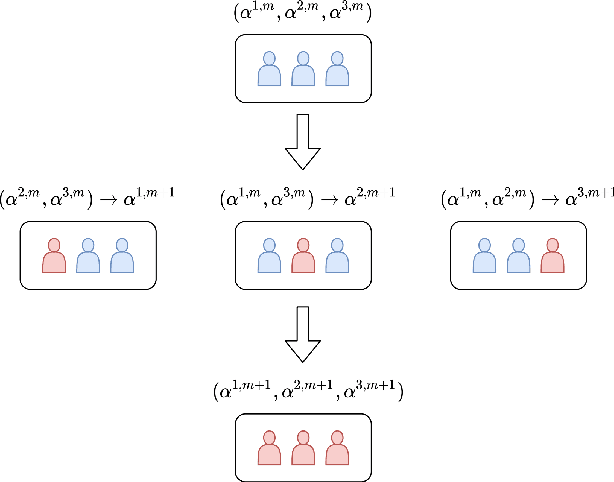
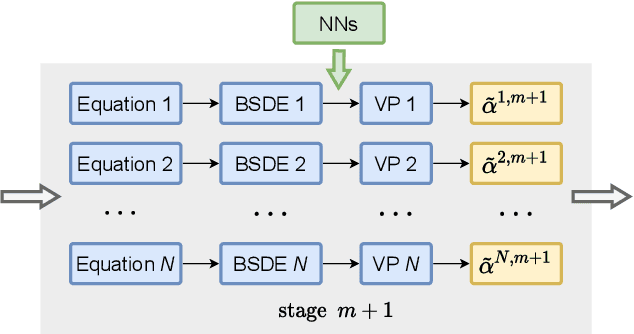
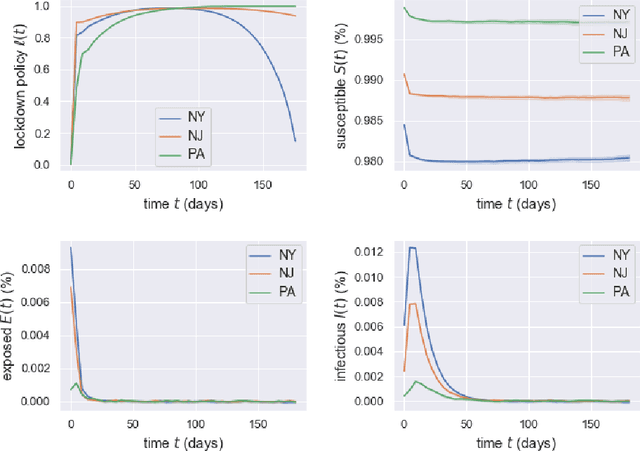
Abstract:Game theory has been an effective tool in the control of disease spread and in suggesting optimal policies at both individual and area levels. In this AMS Notices article, we focus on the decision-making development for the intervention of COVID-19, aiming to provide mathematical models and efficient machine learning methods, and justifications for related policies that have been implemented in the past and explain how the authorities' decisions affect their neighboring regions from a game theory viewpoint.
Differentiable Physics Simulations with Contacts: Do They Have Correct Gradients w.r.t. Position, Velocity and Control?
Jul 08, 2022

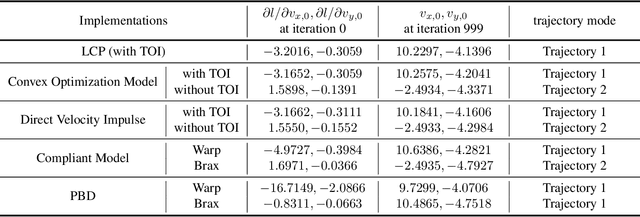

Abstract:In recent years, an increasing amount of work has focused on differentiable physics simulation and has produced a set of open source projects such as Tiny Differentiable Simulator, Nimble Physics, diffTaichi, Brax, Warp, Dojo and DiffCoSim. By making physics simulations end-to-end differentiable, we can perform gradient-based optimization and learning tasks. A majority of differentiable simulators consider collisions and contacts between objects, but they use different contact models for differentiability. In this paper, we overview four kinds of differentiable contact formulations - linear complementarity problems (LCP), convex optimization models, compliant models and position-based dynamics (PBD). We analyze and compare the gradients calculated by these models and show that the gradients are not always correct. We also demonstrate their ability to learn an optimal control strategy by comparing the learned strategies with the optimal strategy in an analytical form. The codebase to reproduce the experiment results is available at https://github.com/DesmondZhong/diff_sim_grads.
Learning High-Dimensional McKean-Vlasov Forward-Backward Stochastic Differential Equations with General Distribution Dependence
Apr 25, 2022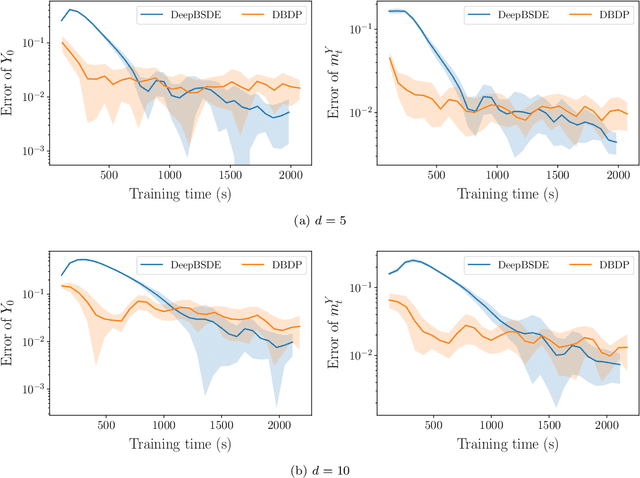


Abstract:One of the core problems in mean-field control and mean-field games is to solve the corresponding McKean-Vlasov forward-backward stochastic differential equations (MV-FBSDEs). Most existing methods are tailored to special cases in which the mean-field interaction only depends on expectation or other moments and thus inadequate to solve problems when the mean-field interaction has full distribution dependence. In this paper, we propose a novel deep learning method for computing MV-FBSDEs with a general form of mean-field interactions. Specifically, built on fictitious play, we recast the problem into repeatedly solving standard FBSDEs with explicit coefficient functions. These coefficient functions are used to approximate the MV-FBSDEs' model coefficients with full distribution dependence, and are updated by solving another supervising learning problem using training data simulated from the last iteration's FBSDE solutions. We use deep neural networks to solve standard BSDEs and approximate coefficient functions in order to solve high-dimensional MV-FBSDEs. Under proper assumptions on the learned functions, we prove that the convergence of the proposed method is free of the curse of dimensionality (CoD) by using the generalized maximum mean discrepancy metric previously developed in [Han, Hu and Long, arXiv:2104.12036]. The proved theorem shows the advantage of the method in high dimensions. We present the numerical performance in high-dimensional MV-FBSDE problems, including a mean-field game example of the well-known Cucker-Smale model whose cost depends on the full distribution of the forward process.
 Add to Chrome
Add to Chrome Add to Firefox
Add to Firefox Add to Edge
Add to Edge